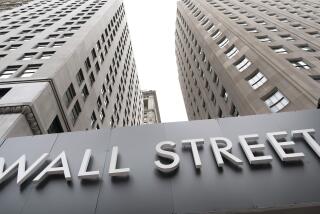Stocks tick higher on Wall Street, but Treasury yields sink

- Share via
U.S. stock indexes drifted higher Tuesday as Wall Street’s big rally eased off the accelerator.
The S&P 500 rose 11.90 points, or 0.4%, to 3,306.51 after flipping between small gains and losses throughout the day. It’s the mildest move for the index in two weeks.
The Dow Jones Industrial Average climbed 164.07 points, or 0.6%, to 26,828.47, and the Nasdaq composite added 38.37, or 0.4%, to close at another record, 10,941.17.
Stock indexes are hanging at or close to their record highs after clawing back all or most of their sell-off from earlier in the year, and the S&P 500 is within 2.4% of its all-time high set in February. But caution is still prevalent across other markets: Gold rose to another record Tuesday, while Treasury yields sank as investors sought safety.
Within the stock market, energy companies had the biggest gains after the price of oil rose. But 2 in 5 S&P 500 stocks were lower following a mixed set of earnings reports.
On the winning end was Take-Two Interactive Software, which rose 5.9%. The video-game maker reported a profit for the spring that was almost double year-ago levels as customers stuck at home played “Grand Theft Auto” and other games instead of going outside.
It also raised its sales forecast for its fiscal year, a notable move when many companies have been shy to give any kind of prediction given all the uncertainty created by the coronavirus pandemic.
On the opposite end was insurer American International Group. AIG fell 7.5% for one of the larger losses in the S&P 500 even though it reported stronger results for the latest quarter than Wall Street expected. Some analysts cited several unusual items that clouded its report, such as COVID-related losses, which make it difficult to extrapolate how AIG’s profits will run from here.
In Washington, meanwhile, negotiations in the Capitol on a big economic relief package are continuing. Multiple obstacles remain before a deal can be struck, one that investors say is crucial for propping up the economy in its weakened state.
A weekly $600 in federal unemployment benefits has expired, threatening to crunch the finances of millions of out-of-work Americans. Recent data reports have shown an uptick in the number of workers filing for unemployment benefits after a resurgence of coronavirus counts pushed some states to reimpose restrictions on businesses. Economists expect a report on Friday to show that U.S. employers added 1.8 million jobs last month, which would be welcome growth but also a slowdown from June.
The Federal Reserve said last week that it will keep interest rates at their record low levels, as it continues to pump massive amounts of aid into the economy. Now, investors are waiting for Congress to do the same.
The yield on the 10-year Treasury note fell to 0.50% from 0.56% late Monday. It tends to move with investors’ expectations for the economy and inflation.
The bond market was much earlier than the stock market to signal the coming economic disaster from the coronavirus pandemic. It has also remained much more cautious through the pandemic than the stock market has.
Gold has been another investment that has moved strongly recently because of low interest rates and worries about the global economy. Gold for delivery in December rose $34.70 to settle at $2,021.00 per ounce.
In Europe, Germany’s DAX slipped 0.4% to give back some of its big gain from a day earlier, when reports showed that manufacturing recovered across much of the continent last month. France’s CAC 40 added 0.3%, and the FTSE 100 in London was up 0.1%.
In Asia, markets were more buoyant. Tokyo’s Nikkei 225 gained 1.7%, the Hang Seng in Hong Kong added 2% and the Kospi in Seoul picked up 1.3%. Stocks in Shanghai edged 0.1% higher.
Benchmark U.S. crude oil rose 69 cents to settle at $41.70 per barrel. Brent crude, the international standard, added 28 cents to $44.43 a barrel.
More to Read
Inside the business of entertainment
The Wide Shot brings you news, analysis and insights on everything from streaming wars to production — and what it all means for the future.
You may occasionally receive promotional content from the Los Angeles Times.










